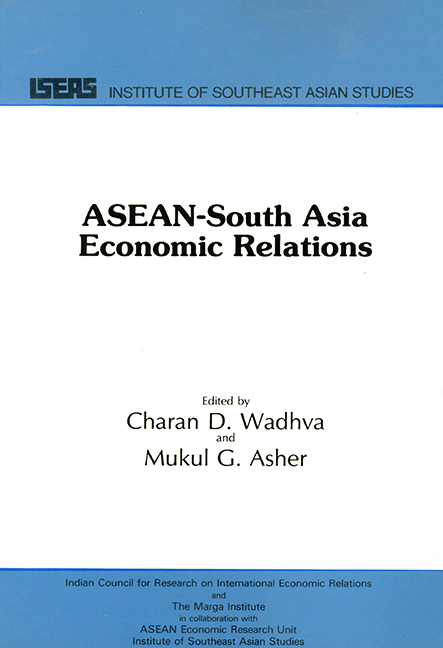Book contents
- Frontmatter
- Contents
- Foreword
- Exchange Rates of ASEAN and South Asian Countries
- An Overview
- PART ONE ASEAN COUNTRY STUDIES
- Economic Relations between Indonesia and South Asia
- Malaysia-South Asia Economic Relations: A Preliminary Study
- Philippine-South Asia Economic Relations
- Economic Relations between Singapore and South Asia
- Economic Relations between Thailand and South Asia
- PART TWO SOUTH ASIA COUNTRY STUDIES
- Postscript
- Appendix SITC Classification at One-, Two-, and Three-digit Levels
- THE EDITORS
Philippine-South Asia Economic Relations
from PART ONE - ASEAN COUNTRY STUDIES
Published online by Cambridge University Press: 21 October 2015
- Frontmatter
- Contents
- Foreword
- Exchange Rates of ASEAN and South Asian Countries
- An Overview
- PART ONE ASEAN COUNTRY STUDIES
- Economic Relations between Indonesia and South Asia
- Malaysia-South Asia Economic Relations: A Preliminary Study
- Philippine-South Asia Economic Relations
- Economic Relations between Singapore and South Asia
- Economic Relations between Thailand and South Asia
- PART TWO SOUTH ASIA COUNTRY STUDIES
- Postscript
- Appendix SITC Classification at One-, Two-, and Three-digit Levels
- THE EDITORS
Summary
INTRODUCTION
Trade contacts between the South Asian sub-continent and the Philippines date back to the pre-Christian era. The late Dr Otley Beyer, an eminent anthropologist and historian, believed that traders from South Asia reached the Philippines as far back as the second or third century BC. The other view is that more lasting Indie influences in Philippine thought, literature and languages came with traders and religious missionaries through intervening cultures around the tenth or eleventh century. These cultural and linguistic influences have remained largely intact beneath the overlays of later Islamic, Christian, and Hispanic influences.
During the Spanish regime (1521-1898), direct trade and cultural links between the Philippines and the rest of Asia were practically cut off except for interaction through the southern islands. However, the British East India Company, operating from its base in Madras, India, together with the English free merchants gradually developed and maintained maritime trade known as “country trade” with countries in the Indian Ocean and the South China Sea. The British merchant ships sailing regularly from Madras and Surat brought cargoes of Indian textiles – “piece goods” – and other products to Manila for onward shipment to Acapulco. “The Manila trade” became an important factor in the British maritime trade in Asia and it also strengthened the British position in Manila vis-a-vis the Chinese traders.
During the American regime that supplanted the Spanish rule, the bilateral free trade between the Philippines and the United States gradually diverted the Philippine foreign trade to the American market. However, trade with India continued to develop even though it remained insignificant in volume.
Between 1905 and 1939, the principal commodities imported from India in order of value included piece goods, gunny bags, cotton twist and yarn, fodder, bran, cattle feed, and husked rice. The exports to India were raw hemp, tobacco, and cordage. The volume of trade remained rather low and the balance of trade was uniformly in favour of India.
- Type
- Chapter
- Information
- ASEAN-South Asia Economic Relations , pp. 115 - 137Publisher: ISEAS–Yusof Ishak InstitutePrint publication year: 1985



